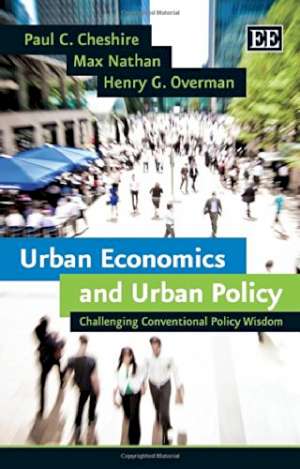28 September 2015
Urban Economics and Urban Policy: Challenging Conventional Policy Wisdom
Paul Cheshire, Max Nathan and Henry Overman
2015, Edward Elgar, 256 pages,
ISBN 9781781952511
Reviewer: Neil Reeder, Director, Head and Heart Economics

Drawing on a distinguished history of research by its authors on economic geography and urban economics at the London School of Economics, this book has the occasional quirky snippet, from the revelation that gardens of the same area are worth more the closer they are in shaoe to a square, to the depiction of cities as ‘gigantic romantic markets for future partners.’
By and large it is, however, a sober academic read, demonstrating how the social, environmental and economic characteristics of places and their people intermingle – as shown by gradients in the way that parks affect local house prices according to their aesthetic appeal, their closeness, and their perceived safety. It is both somewhat surprising and credibly dispiriting that some parks even have the effect of reducing the prices paid for nearby homes – when they are a frequent source of crime.
Central government planning comes across as the book’s dominant theme, and not in a good way. The authors are confident that policy failures over decades have led to many millions of people in Britain today finding affordable housing completely unavailable without commuter marathons. The prime suspect is firmly pinpointed as the 1947 Town and Country Planning Act, which gave overarching priority to agricultural land, and whose overall ethos remains in place. This was an understandable agenda given that Britain came close to starvation during the wartime period, but is rather less justifiable now.
Unfortunately, even minimal reforms to bring in recognition of the insights that price signals bear on the priorities of individuals and society have met with bitter resistance. Politicians either cannot or will not bring about major reforms, not least due to a deep gap between the public’s perceptions of what the Green Belt agenda protects, and what would be achieved by releasing a small proportion of the least beautiful and environmentally valuable land. A ‘utopian system has turned dystopian’, and led to a ‘famine of housing land’. It is to be hoped that policy-makers read this book and realise at least some of its ambitions for creating affordable housing on a scale that is something approaching what is needed to tackle the problem.
Central government policy also faces much criticism in the book for the comparative failure of its efforts over many decades to regenerate unprosperous towns and cities outside London and the South East. The authors’ main contention is that both funding and regulation, when focussed on places of deprivation, rather than people in need, has largely failed to achieve its aims in sustainable ways. This point carries considerable force; yet the ebbs and flows of localities’ prospects (as seen, for instance, in Peter Hall’s Cities in Civilization) suggest, to me at least, that the authors’ assessment cannot be the final word on all the dynamics of the topic. Nonetheless, while the book could perhaps have expanded further on its methodologies here, it should deflate any complacency that urban regeneration has well-honed answers, especially when such actions are directed towards places rather than people.
For its insights into planning and urban regeneration, therefore, Urban Economics and Urban Policy is a clear and valuable read.
